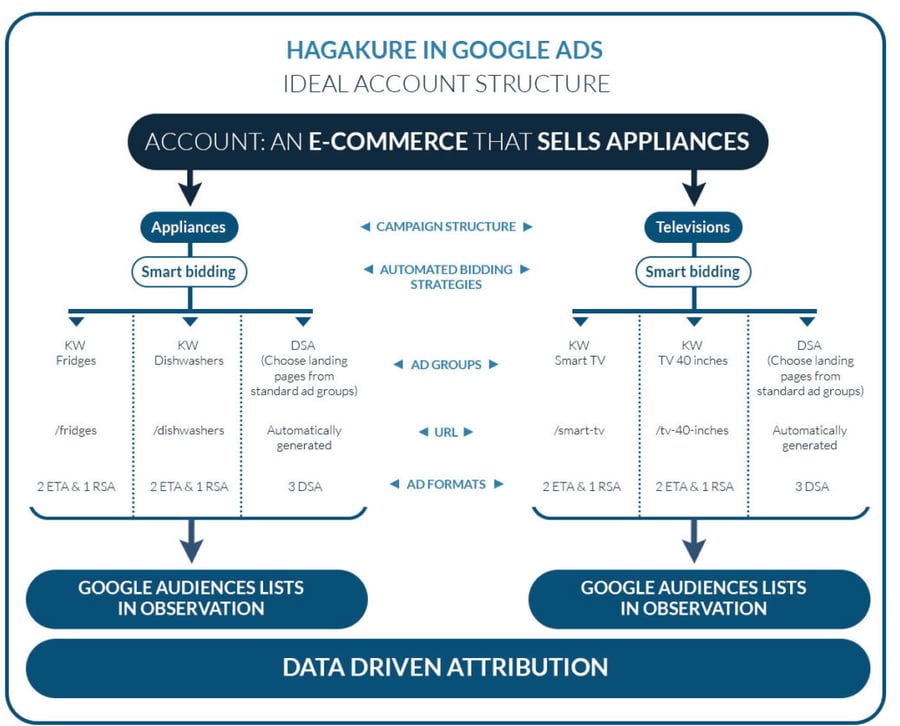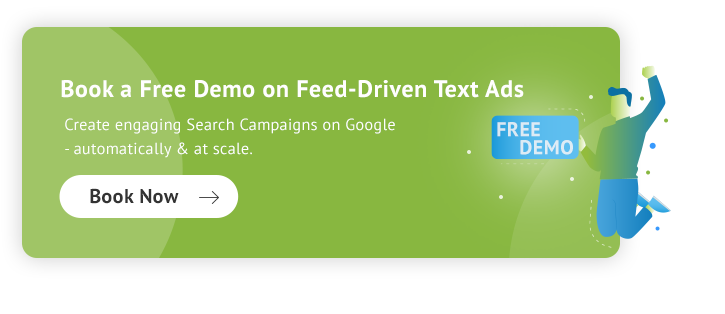PPC managers have religiously held on to the SKAG (Single Keyword Ad Group) structure for a couple of years now.
However, with all the missing search terms, loose match types, and Google’s suggestion to give broad match another chance, I feel that there need to be more structures that could work.
To find out, we have done the research and asked PPC managers what structures they use most often. Here are the ones they mentioned:
1. Single Keyword Ad Groups (SKAGs) with Alpha/Beta Structure
2. Single Keyword Multi-match Type Ad Groups
3. Broad Match Campaign with Smart Bidding
5. Campaigns Split by Age with Smart Bidding
6. Campaigns Split Based on Keyword Performance with Smart Bidding
7. Dynamic Search Ads Campaigns
Today we want to dive into each one of them and understand their most important PROs and CONs.
1. Single Keyword Ad Groups (SKAGs) with Alpha/Beta Structure
In this Google Ads structure you have 2 campaigns with the same keywords but with different match types – usually exact match (EM) and broad match modified (BMM).
The EM campaign is the core campaign and the BMM campaign is used to capture additional search terms that are then moved to the EM campaign as SKAG.
The combination of SKAGs and Alpha/Beta structure is the most common campaign structure. Here are the PROs and CONs of this structure.
Important side note: Google ads are phasing out BMM as match type. Meaning that instead of broad match modified match type you would have to use Phrase match type.
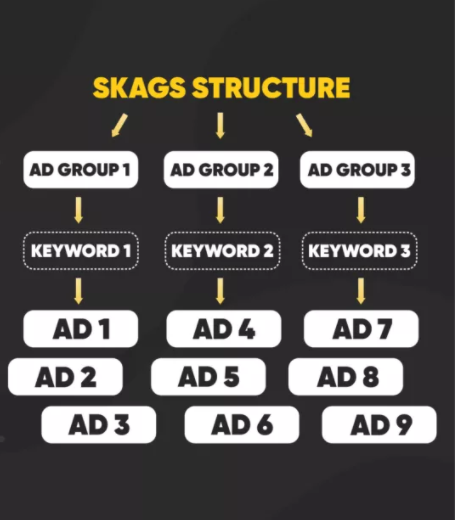
PROs of SKAG campaigns with Alpha/Beta Structure
- Better CTR by tailoring ad copies to the keyword
- Better Ad relevance by tailoring ad copies to the keyword
- Tailoring landing pages to the keyword which improves conversion rates and quality score.
- Better quality score and the effects of it - lower cost per conversion and cost per click as well as better ad rank to name a few.
- Great control over the traffic that is bought in the Exact Match campaign
- Easy cross-campaign negative search term exclusions
CONs of SKAG campaigns with Alpha/Beta Structure
- Potential to overdo it and end up with thousands of SKAGs which are very hard to maintain.
- Data is too scattered which makes it hard to optimize each ad group
- Close match variants make it hard to control the traffic
- For best control, you might need to do cross-ad group negatives. This will make the campaign even more complex and harder to maintain
- Very time consuming
Streamlining Your Single Keyword Ad Groups
SKAG campaigns being one of the most valued campaign structures, I cannot skip one crucial factor that will balance out most of the drawbacks listed. Automation.
High maintenance, time-consuming, not scalable - these are very real hurdles when dealing with SKAGs manually.
How can you turn tables around?
Well, I just happen to work with a great PPC tool that helps advertisers fully leverage the SKAG strategy - Feed-Driven Text Ads.
How Automated Google Search Ads work?
1. Connect your data source (could be your eCommerce platform - like Shopify store, a Google spreadsheet, or another type of file that holds information about your products or services)
2. The DataFeedWatch automated search ads software will pull the input data and use it to:
- create unique keywords per each product / position,
- generate a separate ad group for every product (with a single keyword or multiple keywords per ad group - up to you),
- build specific and relevant ads,
- update your campaigns on a regular basis (eg. turn off ads for unavailable products)
You remain in full control throughout the process - from deciding which data will be utilized for keywords, to ad patterns, to dynamic bidding strategy.

3. Once ready, your Google Search Campaign(s) get automatically created in your Google Ads account and DataFeedWatch performs regular updates according to the logic you assigned in the creation process.
If you’d like to dive deeper into this solution - feel free to book a quick online chat with me. You can also grab a 30-day free trial to experiment and decide where it fits in your PPC strategy.
2. Single Keyword Multi-match Type Ad Groups
In this Google Ads structure you don’t use Alpha/Beta structure. Instead, you only set up 1 campaign. Here is an example:
.png?width=900&name=Google%20Ads%20campaign%20structure%20(3).png)
The amount of match types depends on how broad you want to go. Some advertisers use only 2 match types per ad group, some use broad and exact match. The combination depends entirely on how confident the advertiser is.
Here are PROs and CONs for this structure.
PROs of Single Keyword Multi-match Type Structure
- Leaner structure. The account would have fewer campaigns
- More data on the campaign and also ad group level makes it easier to optimize and also use smart bidding
CONs of Single Keyword Multi-match Type Structure
- No keyword-level control when using smart bidding
- Match types compete between themselves in the auction
- Cross-ad group negatives can take up some time
3. Broad Match Campaign with Smart Bidding
I would not suggest starting out with this campaign structure, but use it on top of the existing setup. For many years broad match was avoided by PPC managers because of how broad search terms it is capturing.
However, Google a couple of months ago said they want advertisers to give broad match another chance. They are claiming that by utilizing broad match and smart bidding you use auction-time signals and the algorithm sets the right bid for each query.
Here are the pros and cons of using this structure:
PROs of Broad Match Campaign with Smart Bidding
- Extra traffic which otherwise would be missed
- Working with Google rather than against their recommended practices
- Smart bidding will set the right bid for each search query
- Increase in conversions
CONs of Broad Match Campaign with Smart Bidding
- Trusting in Google’s algorithms entirely - no control over anything
- A lot of work with negative keyword exclusions
- Google is hiding a % of search terms so it is hard to see what you are buying
- Worse CTR
- Worse Ad relevance
- Worse Quality Score
4. Theme-based Ad Groups
The biggest reason advertisers are starting to use this Google Ads campaign structure is because of loose close match variants. It has made the SKAG structure harder to control.
With this structure, it is up to you how granular you want to split the themes. However, the keywords in the ad group have to match the theme.
Here are two examples of theme splits:
Example 1
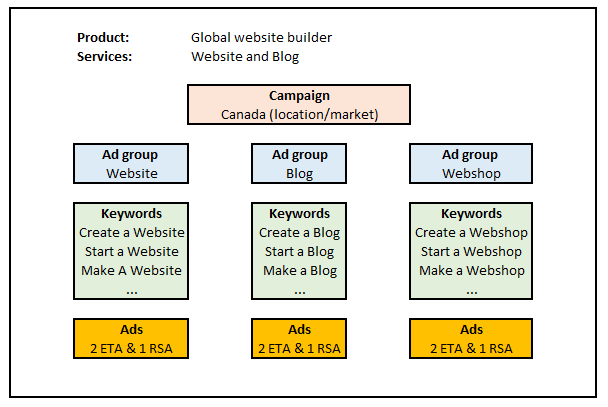 Example 2
Example 2
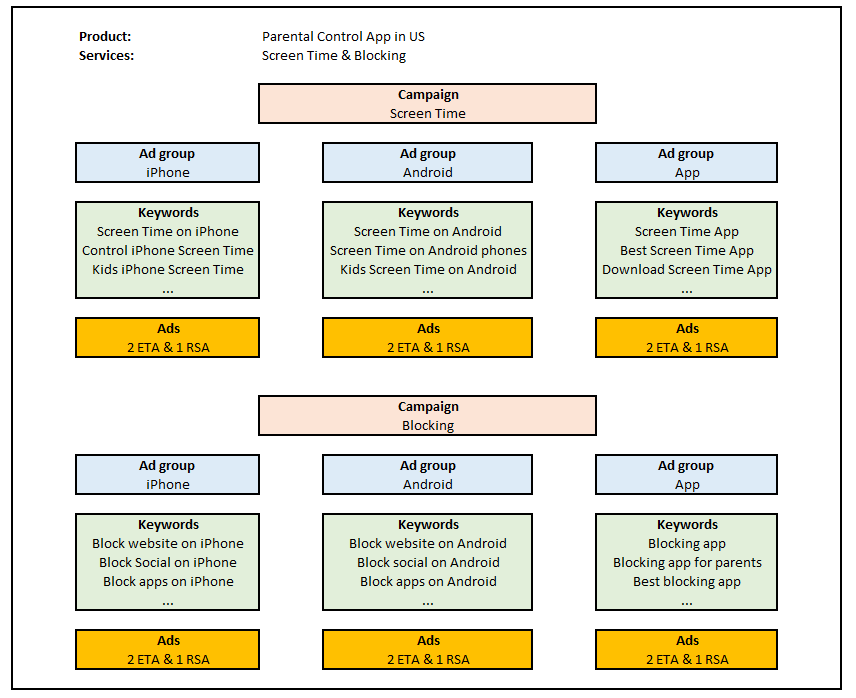 As you can see you can split the themes as you want. But here are the PROs and CONs of this structure:
As you can see you can split the themes as you want. But here are the PROs and CONs of this structure:
PROs of Theme-based Ad Groups:
- Leaner structure with fewer ad groups
- More data on ad group level
- Easy for smart bidding due to more data
CONs of Theme-based Ad Groups:
- Not the best ad copy relevance even with keyword insertion
- Time-consuming to define themes
- Time-consuming to do search term negatives and harvesting
- Lose control on keyword-level when using smart bidding.
5. Campaigns Split by Age with Smart Bidding
Speaking of going too detailed, some advertisers have also said that they split the campaigns by age.
I discussed this with a PPC manager who does this. His company is in a subscription industry where customer lifetime value is a very important metric.
What they noticed is that different age groups have different lifetime values. That means they cannot spend on 18–24-year-olds the same as they spend on 45-54-year-olds. As they are sending back the conversion value to Google, they decided that the best way to control this is by splitting campaigns per age group.
Keep in mind, that they also split the campaign because they use smart bidding, and you can’t use bid adjustments when using smart bidding.
In my opinion, this is a very complex and advanced Google Ads campaign structure, and the account has to have enough data to be able to do such a split.
However, if you see that, for your business, age groups have different LTV or churn, this might be a good way to maximize your ad spend.
.png?width=690&height=276&name=Google%20Ads%20campaign%20structure%20(4).png)
Here are the pros and cons of using this structure:
PROs of Campaigns Split by Age Group
- Leveraging different customer lifetime values
- Better control over traffic when using smart bidding
CONs of Campaigns Split by Age Group
- Scattered data
- Very time-consuming negative keyword exclusions
- Very heavy accounts
- Complex setup
- Very time-consuming to add new keywords
Back to The Top or
6. Campaigns Split Based on Keyword Performance with Smart Bidding
The first step here is to define which performance metric will be used to base the grouping. You can group based on CPC, conversion rates, ROAS, and cost per acquisition (CPA).
Mostly, when smart bidding is applied there will be ad groups or keywords which will over-perform and under-perform because they have different CPC levels or conversion rates. However, the bid strategy will hit the target.
The reason why some advertisers use this Google Ads campaign structure is to maximize the performance of the keywords so that the over-performing keyword doesn’t compensate for the under-performing one.
This is a similar approach to splitting campaigns by age. However, this is the least popular approach.
Here are the PROs and CONs for this structure.
PROs of Keyword Performance-Based Split
- Good performing keywords don’t compensate bad performing ones
CONs of Keyword Performance-Based Split
- Scattered data
- Too many campaigns
- Performance of the keyword can change
- Nightmare with search terms
Related Read: 8 Simple Ways to Reduce Customer Acquisition Costs
Back to The Top or
7. Dynamic Search Ads Campaigns
Let’s first understand what is dynamic search ad (DSA). It’s an ad type that instead of using keywords uses your actual website and the contents of it. Usually, marketers create a separate campaign for them, so it is easier to manage.
You can split the ad groups based on website pages. For example, if you have a separate page for each service. Google would then scrape the content of the page and match it with search queries.
When it comes to actual ads, you only have to write description lines. The rest will be dynamically populated by Google.
From my experience, DSA campaigns can easily be the biggest campaigns by traffic and revenue in some markets.
DSA campaign can be your main driver in the account or used as a supplement for capturing extra searches which you otherwise wouldn’t get.
Check out our full tutorial on how to set up Dynamic Search Ads
Here are the pros and cons of using DSAs.
PROs of DSAs
- Getting extra search traffic
- Easy to create ads
- Headlines of the DSA can be longer than your normal 30 characters which increases CTR
CONs of DSAs
- No control over the headlines of the ads
- No control over search queries
- Can be time-consuming to add negative search terms
- Errors if you change the page structure
- Very difficult to use if having a lot of updates on the pages like daily deals
8. Hagakure Method
The name of this structure comes from a Japanese tradition and it is a title of a piece written by a Japanese samurai.
All fanciness aside, the idea is to make the most simplistic Google Ads campaign structure which maximizes the collection of data on the campaign level. Also, on top of it, it’s necessary to use smart bidding to completely leverage this structure.
Google suggests 3000 weekly impressions per ad group for this structure. So there are 3 ways to be able to reach such a threshold:
- using broader match types
- using DSA
- basing the structure on the URLs instead of keywords
With this structure, you are giving Google all the control. All you are left with is trusting that the powerful algorithms will work in your favor.
Here are the pros and cons of this structure:
PROs of Hagakure Method in Google Ads
- Very simple structure
- Quick and easy setup
- Google takes care of almost everything
CONs of Hagakure Method in Google Ads
- Almost no control
- Time-consuming to exclude irrelevant keywords
- Harder to get high-quality score
- Ad spend wasted on bad search terms
Which is the best Google Ads structure and when to use one?
I have to conclude by saying that there isn’t one winning structure that trumps them all. All of the structures have pros and cons.
In the past, I’ve worked with accounts where I had 4 different structures running. The same products and services but different structures in some countries and languages. Meaning that there was not a specific pattern that can be applied.
There isn’t a structure that works better in one industry or another. However, you can try picking a structure by answering these questions:
- Which campaign structure can I use with the amount of traffic I have?
- Which structure is best with my amount of traffic in order to use smart bidding?
- How much time do I have to optimize campaigns?
This can help you to understand a bit better which structure you need to start with. However, the best way to figure out which is the best structure is by testing them out!
You may also find interesting: 11 Google Search Ads Optimization Tips for B2B Advertisers [EXPERT Level]
